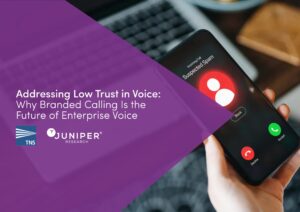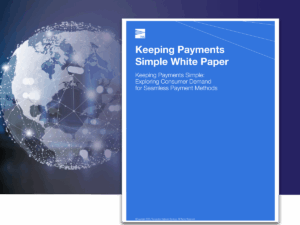The caller ID on your phone may display a number that looks familiar, or the name of a brand you know, but all may not be what it seems. There’s a chance this is a bad actor making a call spoofing attempt.
Caller ID spoofing not only puts us all at risk of falling victim to impersonation scams, but it can also lead to financial and reputational loss for businesses.
Scammers that spoof telephone numbers of legitimate enterprises can have a damaging impact on the ability of those organizations to reach and engage with customers, and their brand reputations.
If an unsuspecting consumer answers a spoofing call and has their personal information compromised, or money stolen, the enterprise that was spoofed may become liable for the loss. Enterprises most at risk are those in ‘high-touch’ or high call volume industries, such as financial services, insurance, healthcare, retail and hospitality.
Here are five of the most common questions on caller ID spoofing:
What is Caller ID Spoofing?
It is estimated that about 70% of scam calls in the US utilize phone call spoofing to deceive victims, but how do call ID spoofers operate?
The Federal Communications Commission (FCC) defines caller ID spoofing in the following way:
“Spoofing is when a caller deliberately falsifies the information transmitted to your caller ID display to disguise their identity. Scammers often use neighbor spoofing so it appears that an incoming call is coming from a local number, or spoof a number from a company or a government agency that you may already know and trust. If you answer, they use scam scripts to try to steal your money or valuable personal information, which can be used in fraudulent activity.”
What are Common Phone Number Spoofing Scams?
The core concept of call spoofing may be simple, but scammers continue to evolve scams using spoofed phone numbers. Some of the most common techniques used by spoofing callers to target consumers include:
Neighbor Spoofing
This technique has become ubiquitous – call ID spoofers use a telephone number that features the recipient’s local area code, sometimes even mirroring the first several digits of the recipient’s own number. Neighbor spoofing has historically been effective as it lures Americans into a false sense of familiarity with the number displayed on caller ID, making it more likely they will answer the call.
Impersonation Spoofing
Fraudsters spoof telephone numbers belonging to known contacts or reputable organizations to execute scams such as:
- Bank Account Scams: Posing as bank representatives to extract private financial data.
- Government Scams: Posing as government officials to acquire sensitive personal information.
- Unpaid Tax Scams: Posing as IRS employees demanding payment for fictitious tax bills and threatening legal consequences.
- Tech Support Scams: Posing as IT providers scanning for issues with the recipient’s computer in an attempt to install malware or steal information.
How Has AI Evolved Call Spoofing?
The arrival of artificial intelligence (AI) has raised the stakes and made the challenge of distinguishing legitimate calls from harmful robocalls even more difficult. Generative AI has made it easier for robocall bad actors to pose as other individuals, using simple free tools available on the internet. There have been reports of scams using AI to create synthetic voices that imitate loved ones, politicians, enterprise executives and business owners.
Bad actors can clone a person’s voice from anywhere it is recorded – voicemail messages, television and videos or recordings on social media. Once they have the voice on file, spoofing callers can use open-source software to make the cloned voice say anything they want it to.
The rise of AI deepfakes in combination with caller ID spoofing means that enterprises that want to enjoy the business benefits of providing high-value customer-facing information through voice calls also need to authenticate and validate this information.
Brand authentication of calls helps protect against caller ID spoofing, ensuring only calls from legitimate brands are delivered with rich content, such as name and logo, to the intended recipient.
What is the Problem with Call Spoofing?
Too often, businesses are unaware that their number has been spoofed until it is too late, and their reputation is harmed, penalties are levied, and their customers are defrauded.
Caller ID spoofing can cause personal distress to subscribers. But the impact of spoofing calls ripples beyond individual cases. In 2024, Americans lost $2.95 billion in imposter scams, such as scammers impersonating government employees or tech support, according to the FTC (Federal Trade Commission).
Research by industry analysts Frost & Sullivan reveals that 74 billion unwanted calls were made to US adults last year, and roughly 70% of scam calls leveraged number spoofing, this resulted in 72% of customers ignoring unknown numbers. Despite these risks, the study also found that customers prefer the personal touch and human interaction of a voice call, as well as the urgency and real-time resolution that the channel offers.
This trend is further validated by TNS independent research, where we found that nearly two in three Americans would prefer to engage with enterprises via a phone call, rather than methods such as texting, apps or websites. This preference was reported across financial services, healthcare, insurance, retail, and hospitality industries.
However, without reliable and authentic solutions that provide rich call data on incoming call screens that prove the caller is who they say they are, the voice channel remains vulnerable to phone call spoofing. The profound implications of spoofed phone numbers run deep for enterprises. These include:
- Reputational damage to the enterprise
- Erosion of customer trust
- Direct financial loss through compensating victims
- Contact center penalties
What is Rich Call Data?
Rich call data allows businesses to deliver critical brand information on incoming call screens, including details like the caller’s name and brand logo. This solution, alongside spoof protection technology, gives customers the confidence to answer calls; promote efficient engagement, and ultimately increase conversion rates.
Only authenticated calls can have enhanced rich call data, meaning your brand won’t become a spam magnet for bad actors. Spoofed calls are flagged as potential spam.
Branded Calling Investment Forecast
In our joint TNS & Juniper Research webinar, it is projected that the market value of branded calling is set to grow from $128 million in 2025 to $2.3 billion in 2030. As more data becomes available surrounding the success of branded calling, such as call answer rates and conversion rates, there will be accelerated adoption due to enterprises being able to quantify the return on investment.
How Can Enterprises Protect Against Call Spoofing?
To mitigate the impact of call spoofing, businesses must take proactive measures, using the latest tools and technology to detect and block spoofing calls in addition to validating legitimate ones.
Protective tools like enterprise authentication and caller ID spoof protection ensures that only verified calls are allowed to reach your customers and immediately blocks non-authenticated calls from using your number.
At TNS, we found that 76% of US adults would prefer to use enterprises that use branded calling solutions to protect customers and that 69% would pay more for services from organizations that offer the highest level of customer protection.
By using a zero-trust policy, which works on the “never trust, always verify” principle, TNS solutions help to ensure that only legitimate, authenticated calls are delivered to a customer’s phone, while blocking and flagging fraudulent ones.
These solutions enable enterprises to protect their outbound calls and provide customers with the peace of mind that when they answer their phone, these are legitimate calls. It also helps to protect the enterprise’s brand, build customer trust, and ultimately, safeguard personal and sensitive data.
By filtering authenticated calls and providing real-time reporting on phone call number spoofing activities, TNS can help enterprises safeguard their reputation, enhance the customer experience and ultimately restore trust to the voice channel.
Jim Tyrrell is Vice President of Global Product Strategy at TNS with specific responsibility for TNS’ Communications Market.
Enterprise Caller ID Spoof Protection
For enterprises looking to bolster their defenses against call spoofing.





